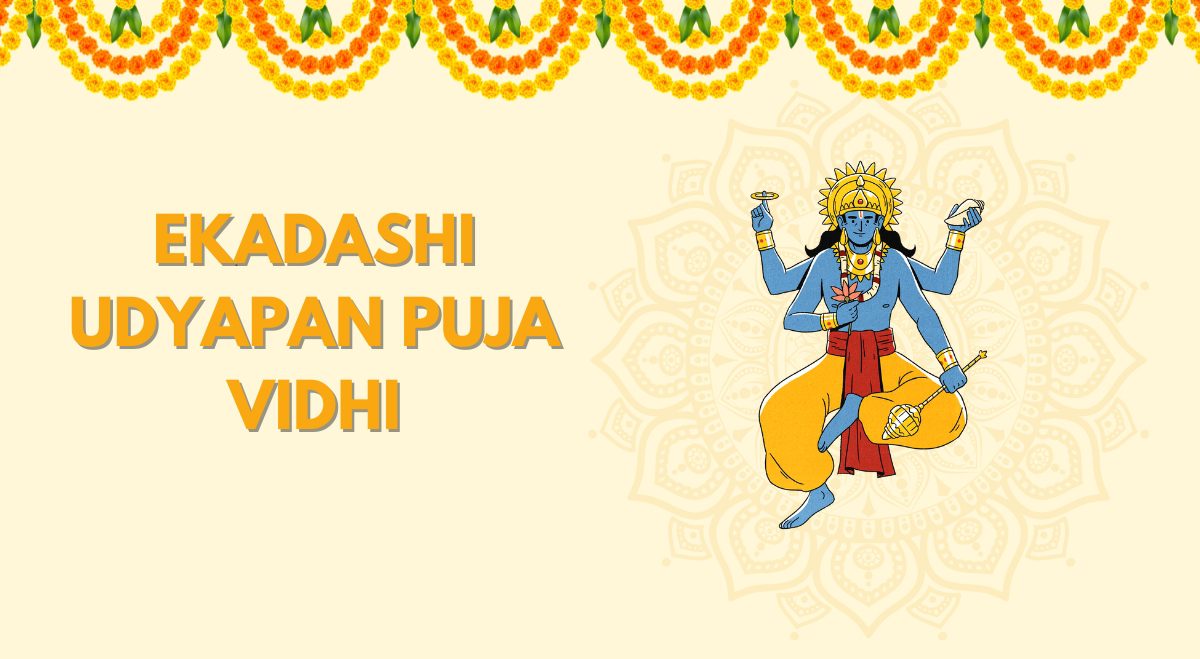The journey of observing Ekadashi fasts is a profound spiritual experience for many devotees. As this sacred practice comes to a close, the Ekadashi Udyapan Puja serves as a beautiful and meaningful conclusion. In this guide, we’ll explore the significance of this ceremony and provide you with a step-by-step approach to performing the Udyapan Puja, helping you complete your Ekadashi vows with reverence and gratitude.
What is Ekadashi Udyapan?
Ekadashi Udyapan is a ceremonial ritual performed to mark the successful completion of a series of Ekadashi fasts. The term “Udyapan” literally means “conclusion” or “completion” in Sanskrit. This puja is typically conducted after observing either 11 or 21 consecutive Ekadashi fasts, depending on one’s vow or spiritual guidance.The Udyapan ceremony holds great significance as it:
- Expresses gratitude to the divine for the strength to complete the fasts
- Seeks blessings for the fruits of the spiritual discipline
- Marks the formal conclusion of the vow, allowing the devotee to move forward
Performing the Ekadashi Udyapan Puja is believed to seal the spiritual benefits gained through the fasting period and invite divine grace into one’s life.
Preparing for Ekadashi Udyapan Vidhi
Before diving into the rituals, it’s essential to prepare yourself and gather the necessary items for the pooja. Here’s what you’ll need:
Items Required for the Pooja
- A clean, sacred space or altar
- Image or idol of Lord Vishnu
- Fresh flowers and garlands
- Incense sticks and dhoop
- Ghee lamp or oil lamp
- Tulsi leaves
- Fruits and sweets for offering (naivedya)
- Gangajal (holy water)
- Chandan (sandalwood paste)
- Akshat (unbroken rice grains)
- Panchapatra (vessel for water)
- Bell
- Conch shell (if available)
Mental and Spiritual Preparation
- Observe a fast on the day of the Udyapan Puja
- Take a bath and wear clean, preferably new, clothes
- Clear your mind and focus on the spiritual significance of the ceremony
- If possible, invite a priest or a knowledgeable elder to guide you through the process
How to Perform the Ekadashi Vrat Udyapan Puja
Now, let’s walk through the step-by-step process of conducting the Ekadashi Udyapan Puja:
1. Sankalpa (Resolution)
Begin by taking a solemn vow to complete the Udyapan Puja with full devotion. This can be done by holding some water, akshat, and a tulsi leaf in your right hand while reciting:”Om Vishno! Aham Ekadashi Vrata Udyapanam Karishye”
(Om Vishnu! I am now performing the Udyapan of my Ekadashi vow)
2. Invoking Lord Vishnu
Place the image or idol of Lord Vishnu on your altar. Light the lamp and incense, and ring the bell. Chant the following mantra to invoke Lord Vishnu’s presence:
“Om Namo Bhagavate Vasudevaya”
3. Offering Prayers and Rituals
Perform the following rituals in sequence:
- Offer water (arghya) to Lord Vishnu
- Apply chandan tilak to the deity
- Offer flowers and tulsi leaves
- Present fruits and sweets as naivedya
- Perform aarti with the lit lamp
During each offering, you can chant “Om Namo Narayanaya” or any Vishnu mantra you’re familiar with.
4. Reciting Vishnu Sahasranama
If time permits, recite the Vishnu Sahasranama (1000 names of Vishnu). If not, you can recite a shorter version or simply chant “Om Namo Narayanaya” 108 times.
5. Expressing Gratitude
Take a moment to express your heartfelt gratitude for the strength and blessings received during your Ekadashi fasting period. You can do this in your own words or use a simple Sanskrit phrase:”Krutartha ‘smi Prabho Vishno Tava Anugrahena Kevalam”
(I am fulfilled, O Lord Vishnu, solely by Your grace)
6. Concluding Rituals
- Perform a final aarti
- Offer pranam (respectful bow) to Lord Vishnu
- Distribute the prasad (offered food) among family members or devotees
Significance of Ekadashi Udyapan Rituals
Each element of the Ekadashi Udyapan Puja carries deep spiritual significance:
- Sankalpa: Represents your commitment and intention to complete the vow
- Invoking Lord Vishnu: Acknowledges the divine presence and seeks blessings
- Offerings: Symbolize surrender and gratitude
- Recitations: Help in focusing the mind and elevating consciousness
- Expressing Gratitude: Cultivates humility and recognizes divine grace
- Distributing Prasad: Shares the blessings and creates a sense of community
By understanding and internalizing these meanings, you can transform the Udyapan ceremony from a mere ritual into a profound spiritual experience.
After the Udyapan: Moving Forward
Completing the Ekadashi Udyapan Puja marks a significant milestone in your spiritual journey. Here are some ways to carry the spirit of your Ekadashi observance forward:
- Reflect on Your Experience: Take time to journal about your fasting journey and the insights gained.
- Set New Spiritual Goals: Use this completion as a stepping stone for new spiritual practices or goals.
- Share Your Knowledge: Consider guiding others who might be interested in observing Ekadashi fasts.
- Maintain the Discipline: While the formal vow is complete, you can continue to observe Ekadashi fasts if you wish.
Conclusion: Celebrating Spiritual Growth
The Ekadashi Udyapan Puja is more than just a concluding ceremony; it’s a celebration of your spiritual growth and dedication. By performing this puja with sincerity and understanding, you not only mark the end of your Ekadashi vow but also set the stage for continued spiritual evolution.
Remember, the true essence of any ritual lies not in its external performance but in the internal transformation it brings about. As you complete your Ekadashi Udyapan, carry with you the lessons, discipline, and spiritual insights gained during your fasting period.
Have you performed an Ekadashi Udyapan Puja? We’d love to hear about your experiences or any unique traditions you follow. Share your stories in the comments below and inspire others on their spiritual journey!

